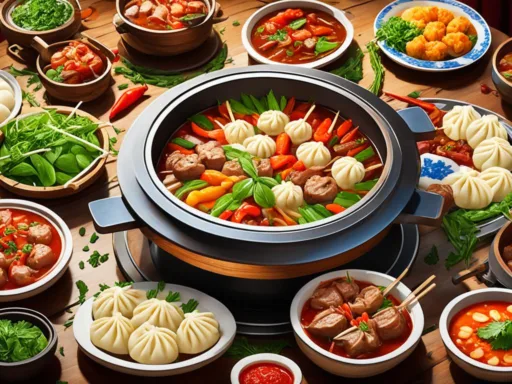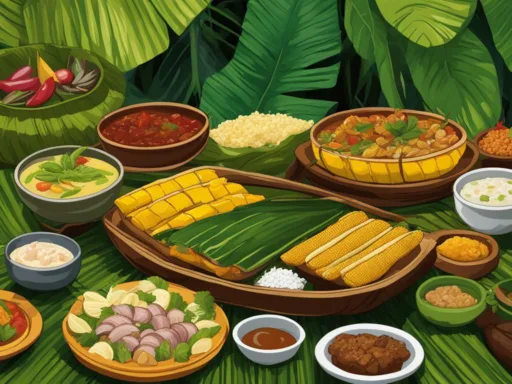Would you believe that Cuban cuisine offers over 500 years of history? This incredible culinary pursuit, known as the Cuban Culinary Journey, invites food lovers to embark on an unparalleled quest into one of the world’s most diverse gastronomic landscapes. The Cuban cuisine exploration is not merely about treating the tastebuds—it’s a deep dive into a cultural synthesis that’s as spirited and vibrant as the island itself. From the bustling streets of Havana to the serene countryside, the Taste of Cuba is an edible narrative, encapsulating flavors and techniques honed over epochs. Join us as we unfold the tapestries of Cuban flavors, each thread representing an integral part of Cuba’s rich culinary tapestry.
Key Takeaways
- 500-year-old culinary history showcased within Cuban cuisine
- Cuba presents a gastronomic journey influenced by Spanish, African, and Caribbean traditions
- Discovering authentic Cuban dishes offers a glimpse into the island’s vibrant culture
- Understanding the significance of sofrito within Cuban culinary foundations
- Engaging with the evolving Cuban food scene through modern interpretations of classic dishes
- Outdoor culinary experiences highlighting street foods and unique Cuban ingredients
- Appreciation for the role of historical elements in present-day Cuban cuisine
An Overview of Cuban Cuisine’s Historical Melting Pot
The essence of Cuban food culture is a vibrant collage, artfully pieced together by centuries of history and the mingling of different communities. Its history stretches back to the indigenous tribes but has been consistently reimagined by external influences. Every turn in Cuba’s timeline has introduced new flavors and techniques, contributing to a culinary narrative that is filled with as much diversity as the nation itself.
One cannot contemplate Cuban culinary traditions without acknowledging the Spanish influence that brought about a transformative phase in preservation and cooking techniques. Curing meats and pickling vegetables became standard practices, integrated with the indigenous methods and ingredients to create a unique blend that truly revives the legacy of the past.
Meanwhile, the Afro-Cuban impact on cuisine can’t be understressed, as it’s synonymous with the introduction of exotic spices and bold recipes that define the characterful Cuban dishes experience today. They brought not only robust flavors but also hearty, soulful cooking that resonates with everyone who experiences a Cuban meal.
The amalgamation of these culinary streams forms an intricate tableau that tells the story of Cuban dishes experience, highlighting the role of food as an historical artifact. Each bite taken from a Cuban dish is a journey through time and culture—an epicurean exploration of the rich tapestry of influences that Cuba proudly presents on every plate.
| Cultural Influence | Key Ingredients | Typical Dishes |
|---|---|---|
| Spanish | Cured meats, olives, citrus | Arroz con pollo, Ropa vieja |
| African | Plantains, yams, taro | Moros y Cristianos, Fufu |
| Indigenous | Corn, beans, pumpkin | Tamales, Ajiaco |
| Caribbean | Seafood, tropical fruits | Ceviche, Guava pastries |
Through this exploration, it’s evident that the Cuban culinary landscape is as much a narrative of its people as it is a
celebration of its survival and ingenuity through changing times
. The living traditions continue to speak to the history of their evolution, and to partake in Cuban cuisine is to experience a surreal blend of history, culture, and unbridled flavor.
Unveiling the Flavors of Cuban Culinary Traditions
The essence of Cuban food culture lies not just in authentic Cuban recipes but in the rich
tapestry of its history and the myriad influences that have shaped its culinary traditions. Widely
acknowledged as a gastronomic hub, the island’s cuisine offers a fascinating window into the
amalgamation of cultures that characterize its past and present. Three major influences have played
a pivotal role in shaping what we now herald as quintessential Cuban cuisine.

The Spanish-Caribbean Influence in Cuban Food Culture
The confluence of Spanish colonialism and local Caribbean traditions gave rise to a palette of flavors
that are synonymous with Cuban culinary practices today. Spaniards brought with them a treasure
trove of spices, cooking techniques, and a penchant for sweet and savory preserves, which have
been enthusiastically assimilated into the Cuban kitchen. Dishes like the savory ropa vieja and the
comforting arroz con pollo are direct descendants of this cultural blend, offering an authentic
taste of Cuba’s colonial heritage.
African Contributions to Cuban Gastronomy
Enduring African influence on the heart of Cuban gastronomy is as pivotal as it is palpable. African
slaves, brought to the island by the colonial powers, introduced not only their labor but their rich
cooking traditions, incorporating ingredients like plantains, yams, and okra. These, in turn, have
become foundational to Cuban gastronomy, essential to the iconic ajiaco stew, and countless
other staples of Cuban cuisine.
The Indigenous Taino Impact on Cuban Cuisine
Before the Spanish and African influences, the indigenous Taino people had already etched their
culinary signatures on the island. These native imprints still manifest in present-day Cuban food
culture, with methods such as barbacoa (barbecuing) leaving an indelible mark. The Taino legacy
also lives on through the use of cassava and guava, ingredients still pervading Cuban culinary
traditions today.
| Spanish-Caribbean | African Influence | Indigenous Taino |
|---|---|---|
| Olives and capers in sauces and as garnishes | Malanga, taro, and plantains in hearty dishes | Cassava-based foods and guava-flavored sweets |
| Sofrito base of onions, garlic, and bell peppers | Techniques like frying and one-pot stews | Barbacoa cooking method contributing to barbecue techniques |
| Pastries filled with seasoned meats | Accompaniments such as fufu and tostones | Use of fresh seafood and tropical fruits |
It is this intricate dance of history, environment, and tradition that endows Cuban culinary traditions with a distinct identity—a cuisine that narrates a tale of convergence and survival, flavored by the genuine spirit of its people. By exploring these layers, one not only discovers delicious authentic Cuban recipes but also gains insight into the enduring legacy of Cuban food culture.
The Foundation of Cuban Dishes: Key Ingredients and Sofrito
The rich tapestry of Cuban flavors is inextricably linked to its fundamental ingredients that serve a dual function — building blocks and culinary compass. The base of many authentic Cuban recipes stems from the holy trinity of sofrito: garlic, onion, and green bell pepper. Meticulously sautéed, these components meld to form an aromatic amalgam infusing dishes with a distinct Taste of Cuba.

It’s this sofrito that anchors classics such as Moros y Cristianos (black beans and rice), imparting a flavor profile that is immediate and comforting, yet complex. The preparation of these elements reflects not only a history of culinary assimilation from French and Spanish cuisines but also exhibits the innovation that characterises Cuban cookery.
Indeed, the simplicity of sofrito disguises its transformative power in Cuban cuisine. The selection of fresh, organic ingredients highlights Cuba’s self-sustained farming practices and its commitment to natural bounties — a testament to the flair for resourcefulness that permeates Cuban kitchens.
The secret to true Cuban cooking lies not in the complexity of its techniques, but in the purity and quality of its components.
- Garlic: Adds an earthy pungency essential to the balance of flavors.
- Onion: Offers sweet, aromatic sharpness, establishing the dish’s backbone.
- Green Bell Pepper: Contributes a mild, vegetal sweetness, rounding out the dish’s profile.
Indebted to the island’s culinary past yet perennially evolving — the impact of the humble sofrito cannot be overstated. It is the echo of history seasoned with the aspirations of contemporary Cuban cuisine, and every forkful taken is a homage to this heritage.
Cuban Culinary Journey: A Voyage Through Aromatic Kitchen Alleys
Welcome to the aromatic alleyways of Cuban cuisine, where each turn presents a new symphony of flavors waiting to be discovered by those embarking on a culinary tour in Cuba. Whether you are craving the well-known staples or eager to uncover hidden delicacies, this journey will tantalize your palate with a variety of experiences representative of the Cuban dishes experience.
Planned Culinary Tours: A Taste of Authentic Cuba
Engage your senses on a guided foray into the heart of Cuban gastronomy. Planned culinary tours offer an exclusive look into the methods and histories behind renowned Cuban dishes. As you traverse the kitchens and dining spots that define a Taste of Cuba, you’ll be treated to stories and tastes that are deeply woven into the local culture.
Street Foods: The Pulse of Cuban Food Culture
Your culinary adventure is incomplete without savoring the vital energy of Cuban street food. Here, the informal eatery stands churn out empanadas, croquetas, and tamales with an authenticity that can only be found amidst the hustle and bustle of Cuba’s vibrant streets. These snacks are not only delicious but are emblematic of the Cuban dishes experience.
| Street Food | Description | Origin |
|---|---|---|
| Empanadas | Savory pastries filled with meats or cheese | Spanish Influence |
| Croquetas | Deep-fried breaded rolls with a ham or chicken filling | European Roots |
| Tamales | Corn-based dough wrapped in a husk, diverse fillings | Indigenous and Spanish Fusion |

As you move from one dish to the next, it becomes clear that a culinary tour in Cuba is more than just a meal—it’s an immersive dive into the history and heart of Cuban culture. The combination of flavors, from the tangy zest of citrus to the subtle warmth of spices, creates an encounter with the Cuban dishes experience that remains with everyone long after the tour concludes.
Delving into Cuban Dishes Experience: From Moros y Cristianos to Ropa Vieja
Cuban food culture is much like a dance—the rhythm of African spices, the melody of Spanish and Caribbean ingredients, all culminating in a symphony of flavors that make Cuban culinary traditions a rich and vibrant celebration. Let’s embark on a delectable journey through Cuban cuisine, revealing the savory main courses, must-try street food snacks, and sweet felicities that articulate the authentic Cuban recipes revered by many.

Classic Cuban Main Courses Worth Savoring
When exploring the hearty soul of Cuban cuisine, dishes such as Moros y Cristianos (black beans and rice) and Ropa Vieja (shredded beef) stand out as testaments of time-honored culinary expertise. These dishes don’t just offer sustenance; they narrate tales of history, resilience, and Cuban flavors.
Snacks and Appetizers: Cuban Street Food Staples
No stroll through Cuban streets is complete without indulging in the ubiquitous street food that pulses with the essence of daily life in Cuba. Delicacies like tostones and croquetas de bacalao mirror the island’s spirit, making them fundamental components of an authentic food experience.
Sweet Indulgences: Cuban Desserts and Their Historical Significance
Cuban desserts carry the baton of Cuban flavors into a realm of sweet bliss. The classic Cuban flan, a creamy caramel-laden custard, and the traditional bruñuelos, a type of fried dough, exemplify the confluence of starch-rich island produce and the Spanish culinary heritage ingrained in Cuba’s gastronomic soul.
| Main Course | Street Food | Dessert |
|---|---|---|
| Moros y Cristianos | Tostones | Flan |
| Ropa Vieja | Croquetas de Bacalao | Bruñuelos |
The Evolution of Traditional Dining: Cuban Cuisine in Contemporary Restaurants
The culinary heart of Cuba is throbbing with new life as today’s chefs steward the authentic Cuban recipes of yesteryear into the realm of modern dining. It’s not only about nostalgia; it’s about evolving the Cuban dishes experience to match the vibrancy of a globalized palate. These culinary artisans draw from the island’s storied gastronomic past, infusing traditional flavors with bold, innovative twists. The vibrant scene at contemporary Cuban restaurants is one where the past and present deliciously intertwine, leaving diners both satisfied and entranced.
The change is not subtle—it’s revolutionary, as Cuban dining establishments embrace the wave of creativity while upholding the core elements that make their cuisine unique. Roaming through the streets of Havana, one can find eateries where the ambience blends seamlessly with the inventive dishes on offer, telling a tale of transformation and renewed identity.
In the heart of Cuba, innovation meets tradition on a plate.
To convey this renaissance of Cuban kitchen mastery, we’ve compiled an eye-opening comparative table that showcases the innovative takes on classic Cuban dishes, as served in some of the most talked-about restaurants on the island.
| Traditional Dish | Contemporary Twist | Ingredients | Chef’s Notes |
|---|---|---|---|
| Ropa Vieja | Deconstructed Ropa Vieja with Plantain Puree | Shredded beef, plantains, red peppers | Deconstruction allows each flavor to shine, with sweet plantain puree complementing the savory beef. |
| Arroz con Pollo | Saffron Arroz con Pollo Croquettes | Chicken, rice, saffron, breadcrumbs | Croquettes offer a crispy take on this classic, with saffron heightening the dish’s luxuriousness. |
| Tostones | Tostones Sliders with Mojo Pulled Pork | Green plantains, pork, garlic, citrus juice | A fun, handheld reinterpretation that packs traditional flavors into a contemporary snack. |
| Flan | Caramel Flan Napolitano with a Meringue Top | Eggs, condensed milk, vanilla, sugar | Elevating the simplicity of flan to an elegant dessert with a sweet meringue crown. |
The allure of such hybrid creations is that they provide both a nod to tradition and a glance toward the future, inspiring a new generation to celebrate and participate in the ongoing story of Cuba’s culinary arts. This is how contemporary restaurants are painting their canvases, with tastes and aromas as their palette, offering an unforgettable Cuban dishes experience that continues to evolve and entice.
Eating Out in Cuba: A Guide to Paladares and Eateries
Exploring the rich Cuban food culture is an unparalleled experience, particularly when dining out in the charming paladares of Cuba. These privately-owned eateries embody the authentic Taste of Cuba, serving up dishes that span the spectrum from traditional fare to inventive culinary delights. Visitors are welcomed into an intimate atmosphere where the fusion of flavors tells the story of a dynamic cuisine shaped by history and tradition.
Variety and Creativity in Cuban Paladares
Paladares have forged a new path in Cuban gastronomy, offering not only classics such as ropa vieja and arroz con pollo but also contemporary dishes infused with global trends. The creativity of Cuban chefs shines through as they adapt to both local and international palates, consistently pushing the boundaries of traditional recipes and presentation. It’s this drive for innovation that keeps the Cuban food scene vibrant and exciting.
Vegetarian and Special Diet Options in Cuban Food Scene
In recent years, there has been a growing trend towards inclusivity in menu offerings, catering to vegetarian and special diet needs. Our foray into the Cuban food scene reveals that these paladares offer an array of options for those with dietary restrictions, ensuring that the inviting flavors of Cuba are accessible to all. The emphasis on fresh, locally sourced ingredients provides a new dimension to vegetarian dishes, allowing even the most discerning diners to explore the island’s culinary diversity without compromise.
- Gluten-Free Cuban Alternatives
- Island-Inspired Vegetarian Dishes
- Health-Conscious Cuban Creations
The growing repertoire of Cuban cuisine is a reflection of the country’s adaptability and openness, enticing visitors to indulge in a dining experience that is both nutritious and enjoyable. As Cuba’s food scene continues to evolve, it promises new culinary adventures that accommodate a broader audience without losing the essence of what makes Cuban cuisine so beloved.
From savory tostones to rich, flavorful beans, Cuban paladares offer a warm embrace to food lovers of all stripes, ensuring that every guest leaves with a satisfied palate and a deeper appreciation for the island’s gastronomic heritage.
Authentic Cuban Recipes for the Home Chef
Embarking on a Cuban culinary journey means bringing a slice of Caribbean zest right into your own kitchen. With a treasure trove of authentic Cuban recipes at your disposal, the home chef can recreate the rich tapestry of flavors that Cuba is famed for. Whether you’re simmering a pot of the classic Ropa Vieja or baking a sumptuous Cuban-style flan, each recipe is a doorway to the island’s storied gastronomic heritage. The beauty of Cuban cuisine lies in its simplicity and profound flavors, making it both approachable for beginners and exciting for seasoned cooks.
Preparing Cuban Classics in Your Kitchen
Imagine the aromas of garlic, cumin, and citrus filling your home as you engage in the preparation of traditional Cuban dishes. Dive into the robust world of Cuban flavors with dishes like Moros y Cristianos, tenderizing meats with mojo marinades, or crisping up some tostones as the perfect side. Authentic Cuban recipes offer step-by-step guidance, ensuring that even the most intricate Cuban delicacies are made achievable for the aspiring home chef. Each ingredient tells a story of culture and culinary evolution, providing insight into the nation’s vibrant food legacy as you cook.
Hosting a Cuban-Themed Dinner Party: Tips and Recipes
For those who wish to share the warmth and lively spirit of a Cuban soiree, hosting a Cuban-themed dinner party is an excellent way to impress guests. Curate a menu from the plethora of authentic Cuban recipes, featuring starters like empanadas or malanga fritters, followed by a succulent platter of Lechón asado. Offer a variety of salsas and dips, and don’t forget to end the meal with some sweet Cuban pastries or creamy cups of natilla. Vibrant table settings, a little son cubano music, and perhaps a Mojito or Cuba Libre in hand, and you’re all set to recreate the ambiance of a festive night in Havana for your friends and family.






